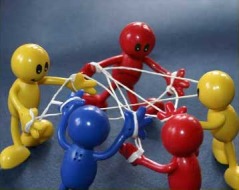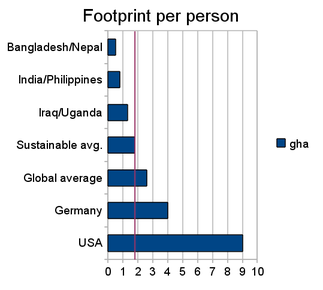Self-organized Plenty
 [Eine etwas ausführlichere Version dieses Artikel gibt es auch auf Deutsch.]
[Eine etwas ausführlichere Version dieses Artikel gibt es auch auf Deutsch.]
This is a handout of the slides of the talk which I gave at FSCONS 2010. So far, a detailed written version of the talk exists only in German (1, 2, 3, 4), but I hope to prepare something similar in English in the foreseeable future.
The Emergence of Physical Peer Production
Commons-based Peer Production
- Commons
- Goods which are jointly developed and maintained by a community and shared according to community-defined rules.
- Peer production
- People cooperate voluntarily on an equal footing (as peers) in order to reach a common goal.
- Commons-based peer production
- Peer production which is based upon commons and which creates new commons or maintains and fosters the existing ones.
Guidelines for Successful Cooperation
- Find other people who have the same (or a similar) problem or goal as you.
 Every good work of software starts by scratching a developer’s personal itch.
Every good work of software starts by scratching a developer’s personal itch.– Eric Raymond, The Cathedral and the Bazaar
- Join forces with them in order to produce what you want to have or achieve (need-driven production).
- Be fair and accept the others as your peers—since you all participate voluntarily, nobody can order others around.
- Be generous and share what you can. By doing so, you’ll attract further users, some of whom will sooner or later turn into contributors.
There is rarely a clear separation between users and contributors, but rather a smooth transition: most participants use your product only, some contribute occasionally, and a small percentage contributes intensely on a long-time basis.
- Be open and welcoming to make it easy for “newbies” to join and contribute to your project.
- Leave hints on what there is to do and which contributions you would like to see (stigmergy).
Frequently some other participants will take up a hint and self-select to handle one of the wanted tasks. The more participants care for a task, the more visible the hints will be, increasing the chance that somebody self-selects for the task.
Sample hints:
- To-do lists, bug reports, feature requests
- Wikipedia: “red links,” “most wanted articles”
- Jointly develop the rules and structures that are most suitable for reaching your goals.
- Strive to reach rough consensus regarding the goals of your projects and the best ways of realizing them. Narrow or arbitrary decisions will tend to drive away the people that disagree with them.
 We reject: kings, presidents and voting.
We reject: kings, presidents and voting.
We believe in: rough consensus and running code.– David Clark, Internet Engineering Task Force
- But if you really can’t agree on an issue, that’s not so bad. Just fork the project and do your own thing.
The Three Freedoms
- The freedom to use the work for any purpose.
- The freedom to study the work and to change it to make it to do what you wish.
- The freedom to distribute and share the work with others, so that the whole community may benefit.
Combinations of the three freedoms must be possible, too. The Free Software Definition specifies a fourth freedom that combines the preceding two (distribute modified versions).
 Copyleft ensures that the three freedoms will also hold for all derived works: I may only published derivative versions if I give all their users the same rights.
Copyleft ensures that the three freedoms will also hold for all derived works: I may only published derivative versions if I give all their users the same rights.
Material Plenty and the Eco-Footprint
- Ecological Footprint
- The amount of biologically productive land and sea area needed to regenerate the resources a human population consumes and to absorb and render harmless the corresponding waste.
Currently, humanity’s ecological footprint is 17.1 billion global hectare, but the available biocapacity is only 11.9 billion global hectare. In the long run, such overuse is impossible—by consuming Earth’s resources faster than they can be renewed, we live at the cost of future generations.
But not everybody does, since resource usage varies wildly by region:
 >→ We in the Global North also live at the cost of people elsewhere.
>→ We in the Global North also live at the cost of people elsewhere.
Material plenty for all is only possible within the limits of the available biocapacity, i.e. with a sustainable ecological footprint. This excludes plenty in the sense of “waste as you like,” but not necessarily plenty as “just what you need.”
Material Plenty for All?
In capitalism, material plenty for all is impossible. Peer production is more promising, since it is need-driven: people produce in order to satisfy their productive or consumptive needs and desires, not in in order to turn money into more money.
Fulfilling my needs does not necessarily come at the cost of others nor at the cost of nature. On the contrary, peer production works so well because the participants help each other to reach their goals and fulfill their needs. Everybody benefits.
Distributed Commons-based Production
“It’s possible to copy physical things, provided you have access to the complete design and to the required resources and means of production.”
With peer production, the necessary resources and means of production tend to be commons or distributed widely. The most important resource required for digital peer production is knowledge, which is generally treated as a commons.
Imagine a world in which every single human being can freely share in the sum of all knowledge.
– Wikimedia Foundation
Free and open design (free knowledge on how to manufacture goods) is an important building block for physical peer production.
Free and open design is not enough for physical production—access to land and other natural resources is essential as well. In the logic of peer production, these too become commons to be used and shared in a fair manner among all. Commons must also be maintained and preserved for future generations. That’s the second building block.
Even a whole society, a nation, or even all simultaneously existing societies taken together, are not the owners of the globe. They are only its possessors, its usufructuaries, and, like boni patres familias, they must hand it down to succeeding generations in an improved condition.”
– Karl Marx, Capital III
With digital peer production, the physical means of production (e.g. computers) tend to be distributed among many people. Their widespread distribution prevents asymmetric dependencies—there is no single person or entity that can control their usage and hence their users.
A similar development starts to occur in the area of physical peer production: the emergence of a decentralized, self-organized productive infrastructure making it possible for everybody to get access to the means of production.
Examples:
- Mesh networks such as the Scarborough Wireless User Group (South Africa) establish a shared infrastructure for Internet and telephony—and maybe soon for power and water?
- Hacker spaces are self-organized places where people can produce, learn, and relax.
- Fab labs host tools (CNC routers, 3D printers…) that allow distributed production.
Nowadays, the required tools and machines are usually proprietary and have to be bought from big corporations. But as soon as it becomes possible for peer production to produce its owns tools, the circle will close: Peer producers can jointly produce, use and manage their own productive facilities, thus overcoming the dependency on proprietary, market-driven production.
That’s the third building block of physical peer production, while the fourth and most important building block are the voluntary contributions of peers without which peer production wouldn’t exist.
Resource Fairness
“Be fair and accept the others as your peers” → But what if some are unfair, for example permanently consuming a larger share of resources than sustainable?
In peer projects, perceived misbehavior is typically dealt with by flaming and shunning. It that’s insufficient, boycott and exclusion (strategic non-cooperation) remain as more severe consequences.
Without cooperation with others, nobody will get very far. Hence strategic non-cooperation by a large number of projects and people should usually be sufficient to sanction and stop misbehavior.
Task Fairness
Tasks in peer projects are usually distributed on the basis of self selection and stigmergy. What if this doesn’t work—if there are some tasks that people consider important but that nobody is willing to do? Possible approaches for dealing with this problem include:
- Automation: automate these tasks (or their unpleasant aspects), letting machines instead of people handle them.
- Reorganization: reorganize these tasks to make them more pleasant (more entertaining, more interesting, easier) in order to attract more volunteers.
If neither approach is possible, the unpleasant tasks can be shared in a fair manner: if everybody (or everybody who cares) does a small part of such tasks now and then, they can be dealt with without causing much trouble to anybody.
Resources
- Book: Siefkes, Christian. From Exchange to Contributions. Edition C. Siefkes, Berlin, 2007. License: Creative Commons BY-NC-SA.
- German translation: Beitragen statt tauschen. AG SPAK Bücher, Neu-Ulm, 2008. License: Creative Commons BY-SA.
- Website: http://peerconomy.org/
- Group weblog: http://www.keimform.de/
- Articles in English: http://www.keimform.de/category/english/
- Images Used:
- Eric Raymond: http://commons.wikimedia.org/wiki/File:Esr.jpg, author: Russ Nelson, license: public domain.
- David Clark: http://commons.wikimedia.org/wiki/File:David_D_Clark_in_office.jpg, author: Garrett A. Wollman, license: CC-BY 3.0.
- Nina Paley, Nik Phelps, Connie Champagne: Copying Is Not Theft. http://questioncopyright.org/minute_memes/copying_is_not_theft, license: CC-BY-SA 3.0.
- Bike sharing in Spain: http://commons.wikimedia.org/wiki/File:Punto_de_recogida_situado_en_el_conservatorio.JPG, license: CC-BY-SA 3.0.
- Karl Marx: http://commons.wikimedia.org/wiki/File:Marx_color.jpg, license: CC-BY-SA 3.0.


3 Kommentare